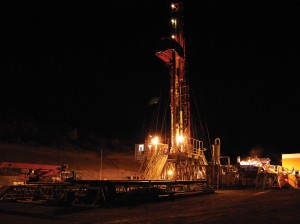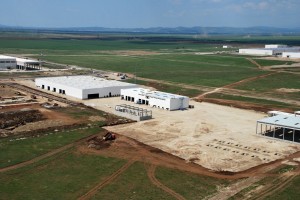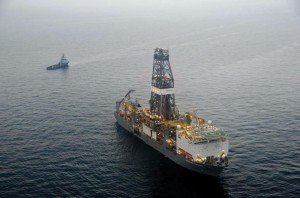Shales, technologies, cultural shift refuel Romanian industry
Eastern European country works to ramp up drilling of unconventional, deepwater resources, enhance HSE
By Joanne Liou, editorial coordinator

At the foothills of the Carpathian Mountains, the sight of new facilities at Industrial Park near the city of Ploiesti is a testament to Romania’s regenerating oil and gas industry. The collapse of the country’s communist regime in 1989 abruptly reversed its upward trend of bustling activity and the record number of meters it had drilled that decade. Since 2004, however, the country itself and incoming foreign companies have transformed the drilling scene as Romania experiences an industrial and cultural renaissance.
Since the first well was drilled in 1861 in this eastern European country bordering the Black Sea, more than 70,000 wells have been drilled, Leo Maekiaho, OMV Petrom head of well engineering development, stated at the IADC Critical Issues Continental Europe 2012 Conference and Exhibition in May in Bucharest. Mr Maekiaho was a keynote speaker and moderator addressing HSE culture. He noted that Romania reached record activity level in 1984, drilling about 7.2 million ft (2.2 million meters) in approximately 1,500 wells with 250 rigs that year.
Today’s numbers reflect a stark contrast but with good reason. Although the activity of the ’80s was characterized by high quantity, it was not necessarily high quality. Fast forward into the 21st century and the country is drilling approximately 200 wells per year. “We make sure all the wells we drill are the right ones,” Mr Maekiaho said. “That means that they will deliver the resources we’re expecting and that they will be economical.”
Romania is one of the most active and highest-producing countries in Continental Europe, with up to 20 onshore rigs and two jackups operating, Mr Maekiaho said. In 2011, Romanian production amounted to 92,000 bbl/day of oil and 1.16 BCF/day of gas.
Critical Issues
The challenges Romania faces are not unheard of in other drilling markets; however, remnants of the country’s political and cultural environment compound issues that might be considered history in other parts of the world. The Romanian industry has been experiencing a transformation period involving establishment of safety practices, standards and, most importantly, a competent work force.

When OMV bought Petrom and entered Romania’s drilling scene in 2004, the company implemented a new HSE program, but it was not well-received. “We have a mentality problem. We are an ex-communist country,” Dumitru Bujoi, HSE coordinator at Mavlo Invest, said. Romania-based Mavlo Invest provides HSE training and PPE and is working with OMV Petrom, among other companies, to improve HSE programs. “The big challenge is to make everyone cautious that safety is a priority.”
When Mr Bujoi began providing training courses three years ago in Romania, he observed how drilling crews would associate HSE with a single person, such as an HSE officer, instead of with a responsibility and action necessary for the entire crew.
Crews lacked understanding of safety measures, and the culture skewed to the expectation that accidents were inevitable. Mr Bujoi referred to a conversation he had about a year ago with a local drilling contractor’s safety officer who was convinced that it was impossible to achieve zero incidents. “If we don’t wake up in the morning and go to work with this target in our mind, that means we go to work and we expect somebody to get hurt,” he said.
Sometimes crews may not understand the purpose of specific safety measures. On one occasion, a derrickman was told that he had to wear a safety harness, and he did. “But he failed to attach it to anything, basically not understanding that the fall protection is useless if it’s not complete,” Mr Bujoi explained.
Instilling safety into culture is a fragile task as it not only involves implementing programs but also cultivating a new way of thinking and acting. Companies, such as Foraj Sonde Craiova, a Romanian onshore drilling and well services company, have implemented HSE programs to help bring the local industry up to global standards. Foraj Sonde implemented its new HSE program in 2006. “It was successfully implemented because we are in the third consecutive year without incidents and accidents,” Ion Croitoru, president of Foraj Sonde, told Drilling Contractor. “Over 80% of personnel involved in drilling operations have completed the two modules of oil drilling courses accredited by IADC.”
The country has made strides in safety, and the momentum is there to continue to progress. “If we compare the safety culture from three years ago with today, it is a big change in the mentality of the people and we are heading in the right direction, although a lot of things have to be changed,” Mr Bujoi stated.

With the decline of E&P activity after 1989, national drilling schools and vocational schools that provided training shut their doors and left Romania without a source to supply and train its work force. “In the old-time Romania, they had very good schools. They provided people for all around the world,” Mr Maekiaho said. “Now the older generation is about to retire. The young ones in between have not had more onsite, formal training. (Drilling schools) are something we need to support to re-establish formal training in Romania.”
Looking to other resources, Mr Maekiaho advocated collaboration with local universities to recruit talent, work on drilling equipment-related research projects and instill higher standards of potential recruits. OMV Petrom recently established a laboratory in Romania for pipe threads connections tests to meet specifications set by the European Union, including ISO standards, which are linked to API standards. “Now, they need workers,” he stated.
Although the political landscape is still finding its own ground, Mr Maekiaho hopes that authorities will step up to ensure compliance of existing regulations. “In most European countries – Norway, UK, Holland and Denmark – they have very strong bodies that do check compliance,” he explained. “Particularly in Romania, the governance needs to check that regulations you have agreed to follow are followed.”
Technology, Activity
Operators and drilling contractors are making leaps to implement new technologies and to venture into uncharted territory in Romania. “The drilling operators are focusing on the total drilling costs, how to improve drilling efficiency and reducing flat time,” Mr Croitoru said. Foraj Sonde currently has 20 operational rigs ranging from 600 hp to 2,400 hp.
OMV Petrom recently introduced rotary steerables and drilling with casing in Romania to improve efficiency and reduce costs. The company believes it could drill 500 more water-injection wells in addition to its current plans to drill between 150 to 200 E&P wells over the next five years. Mr Maekiaho explained that by utilizing primary and secondary recovery methods, such as water injection, and conducting open-hole completions using stand-alone screens and swellable packers, OMV Petrom can double its production.
In Q1 2012, ExxonMobil and OMV Petrom completed their first deepwater well in 3,051 ft (930 meters) in the Black Sea with Transocean’s Deepwater Champion drillship. “We had to do modifications but not too much, and it was a generally good performance,” Mr Maekiaho said. “However, it is larger than we need and thus more expensive than a smaller rig that can still drill our wells since these wells are not in ultra-deepwater.” The exploratory well was drilled to 12,336 ft (3,760 meters) TD. Through the OMV Petrom and ExxonMobil JV, there are plans to increase its deepwater activity next year by drilling additional appraisal wells.
Shale Prospects
Just as the prospects for shale activity are beginning to come to light, pushback is quick to follow. “In Eastern Europe, a prime motivator for shale-gas development is to reduce dependency on Russia’s natural gas imports,” Brian Petty, IADC executive vice president – government affairs, said at the IADC Critical Issues Continental Europe. Mr Petty was speaker during the shale gas panel addressing challenges and differences between shale-gas development in the US and Europe.
Romania elected a new government in May, which called for a moratorium on hydraulic fracturing. “In Europe, France, Bulgaria and perhaps Romania stand alone in the EU in imposing moratoria,” he said. “Poland, Hungary, the UK and Ukraine are actively pursuing shale-gas development.”
Companies are assessing reservoir potential that extend from the Baltic Sea to the Black Sea. Learning from North America’s shale drilling experience, companies are also being cognizant in their pursuit in Eastern Europe. “Romania started to evaluate the potential that shale gas formations exist. Some parameters and areas (of) the theoretical considerations say that there can be a good potential in this resource,” Mr Croitoru stated. However, he emphasized “the importance of full transparency, measuring and monitoring of environmental impacts and engagement with local authorities and communities. The society should not underestimate the substantial investment in complex technology to do so in a safe and responsible way.”




